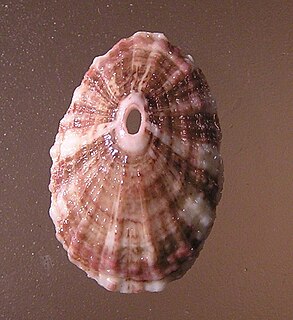
Incisura rosea, common name the rosy slit shell, is a species of minute sea snail, a marine gastropod mollusc in the family Scissurellidae.
Tricolia elongata is a species of sea snail, a marine gastropod mollusk in the family Phasianellidae.

Phasianella solida, common name the solid pheasant, is a species of sea snail, a marine gastropod mollusk in the family Phasianellidae.

Tricolia capensis, common name the pheasant shell, is a species of sea snail, a marine gastropod mollusk in the family Phasianellidae.
Tricolia retrolineata is a species of sea snail, a marine gastropod mollusk in the family Phasianellidae.

Tricolia speciosa, common name the Mediterranean pheasant, is a species of sea snail, a marine gastropod mollusk in the family Phasianellidae.

Fissurella rosea, common name the rosy keyhole limpet, is a species of sea snail, a marine gastropod mollusk in the family Fissurellidae, the keyhole limpets.

Phenacovolva rosea, also known as the rosy spindle cowry, is a species of sea snail, a marine gastropod mollusc in the family Ovulidae, the ovulids, cowry allies or false cowries. It lives and feeds on fan, whip and bush-type gorgonians.

Eulithidium comptum, the Californian banded pheasant shell, is a species of small sea snail with calcareous opercula, a marine gastropod mollusk in the family Phasianellidae, the pheasant snails.

Tricolia bicarinata is a species of small sea snail with calcareous opercula, a marine gastropod mollusk in the family Phasianellidae, the pheasant snails.
Tricolia fordiana is a species of small sea snail with calcareous opercula, a marine gastropod mollusk in the family Phasianellidae, the pheasant snails.

Tricolia gabiniana is a species of small sea snail with calcareous opercula, a marine gastropod mollusk in the family Phasianellidae, the pheasant snails.
Tricolia insignis is a species of small sea snail with calcareous opercula, a marine gastropod mollusk in the family Phasianellidae, the pheasant snails.
Tricolia milaschewitchi is a species of small sea snail with calcareous opercula, a marine gastropod mollusk in the family Phasianellidae, the pheasant snails.
Tricolia pulchella is a species of small sea snail with calcareous opercula, a marine gastropod mollusk in the family Phasianellidae, the pheasant snails.
Eulithidium pulloides is a species of small sea snail with calcareous opercula, a marine gastropod mollusk in the family Phasianellidae, the pheasant snails.
Tricolia substriata is a species of small sea snail with calcareous opercula, a marine gastropod mollusk in the family Phasianellidae, the pheasant snails.
Tricolia tomlini is a species of small sea snail with calcareous opercula, a marine gastropod mollusk in the family Phasianellidae, the pheasant snails.
Tricolia tristis is a species of small sea snail with calcareous opercula, a marine gastropod mollusk in the family Phasianellidae, the pheasant snails.
Tricolia variabilis, common name the minute pheasant, is a species of small sea snail with calcareous opercula, a marine gastropod mollusk in the family Phasianellidae, the pheasant snails.









